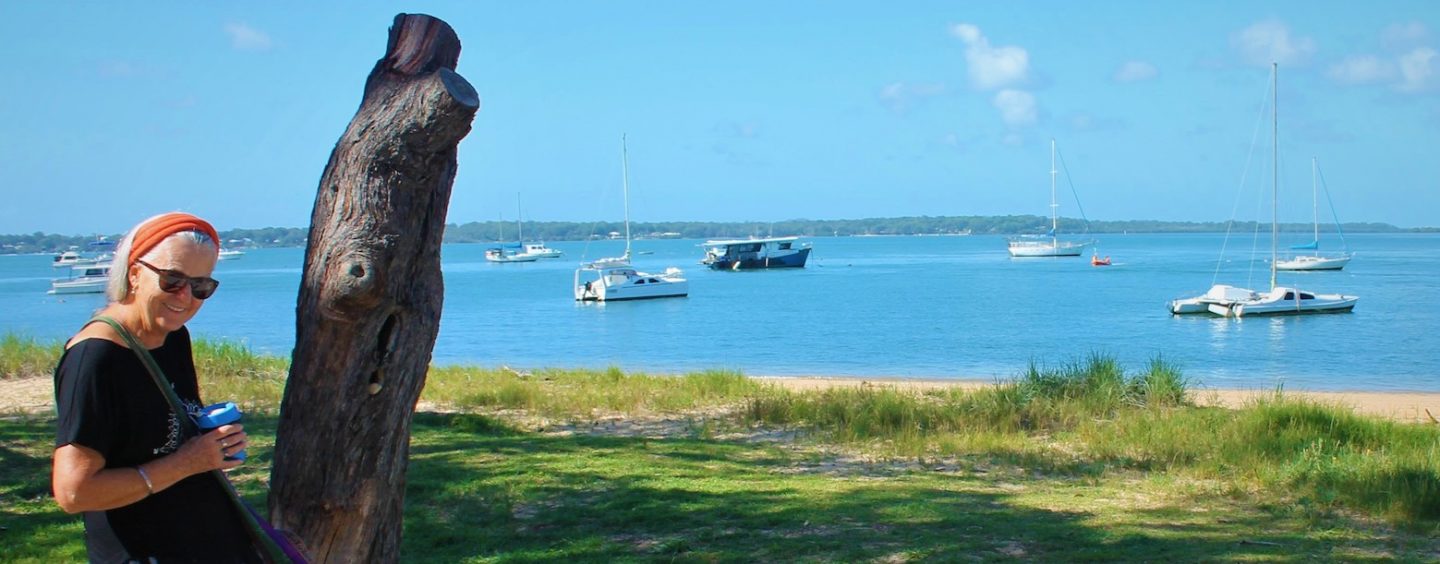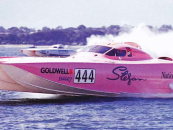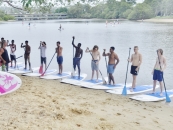“What about Coochie, as the locals call it? I have only been there once 20 years ago, but I think there’s a café. And there’s probably more there now because that was so long ago,” suggested my sailing buddy, Richard, when we were looking for somewhere new to explore.
Richard had visited Coochiemudlo Island years ago when his elderly mother lived there, but had kept its secret well, and never told me there was anything ashore.
Motoring past Coochiemudlo Island in southern Moreton Bay, you could be forgiven for thinking it is almost undeveloped because it looks so pristine. Greenery proliferates and the only large visible structure is the jetty on the southern side. Stop off to explore, and you’ll soon discover how wrong first impressions can be. This beautiful island does indeed boast the unspoilt natural environment its exterior promises, but excellent onshore facilities as well.
It was only when we pulled our powerboat onto the beach months ago, after sailing or motoring past the island many times, I discovered how much Coochiemudlo has to offer. So off we set to discover, or – in Richard’s case – rediscover, what Coochiemudlo has to offer.
LOCATION
Coochiemudlo lies a kilometre off Victoria Point in the Cleveland area just to the south of Brisbane, north of Macleay Island and west of North Stradbroke Island.
The deeper-water and main anchorage is on Main Beach on the southern side of the island, to the east of the jetty used by the ferry, which services the island from Victoria Point. This is exposed to the prevailing south-easterlies, but there are alternative anchorages on the other sides. It is wise to navigate with care around the island and time your visit to avoid ultra-low tides. The Beacon to Beacon guide warns of shoaling water and rocks in several places.
We launched at the excellent two-lane boat ramp at Masters Avenue in Victoria Point, and after a short motor we pulled up at the main anchorage near the jetty, leaving the runabout anchored out to allow for the falling tide. Skull-dragging a boat across sand flats if you are stranded is not something I ever want to do again.
Stepping ashore, the first place we headed was to say hello to the members of the Coochiemudlo Surf Lifesaving Club, who were patrolling a flagged swimming area to the west of the jetty. They told us that members patrolled the beach on weekends from October through summer.
The lifesaver in charger, Russell Rubie, was proud of their strong Nipper program. “Coochie has three beautiful sand beaches, and they are the closest sand beaches to Brisbane so we get lots of families from Brisbane,” he said. The three beaches are called Main, Morwong, and Norfolk.
There were boat-hire signs on old-fashioned aqua bikes, tinnies and barbecue pontoon boats. It is recommended to book ahead if you want to hire a boat, as opening hours vary.
BEYOND THE TREES
Heading inland, we found that a whole new world does, indeed, lie behind the trees. A map at the end of the jetty helps you orientate yourself.
A children’s playground is the first thing you encounter, with beach showers, amenities block and free electric barbecues adjacent. Beyond the playground is the Curlew Café, a thriving little café that also sells essentials like milk and ice. The Red Rock Café is a short walk to the east.
A real estate agency sign outside a small office around the back of the Curlew Café drew our attention. Here we struck gold. Even though it was a Sunday, Denise Foley of Baywaters Realty was there, and happy to share her wealth of knowledge. She volunteered to drive us on a quick impromptu tour of the island. Amazingly, Denise remembers Richard’s elderly and eccentric mother from when she lived there many years ago. She has been in real estate for more than 40 years and lived on the island since the 1970s.
Denise told us much of the five-square-kilometre island is freehold, apart from a publicly owned green fringe around most of the island, which is the reason it looks undeveloped from a distance. The locals call the green belt the “verdant fringe”, and are justifiably proud of it.
About 700 people live on the island and Coochie is known for being a busy and caring community. Facilities include a nine-hole golf course, BMX track, recreation club, tennis and croquet courts and a library. A recreation reserve is even named after Denise’s late second husband, Laurie Burns, who was a builder who helped create many of the communal facilities.
Unlike many other islands, Coochie has water, sewage and electricity, partially due to its proximity to the mainland, but also because of its manageable size compared to some of the larger nearby islands.
“We have never had too much of an issue getting funding,” Denise explained. “The Coochie community has a great reputation for getting things done.”
A 10-15-minute walk to the west of the jetty, you will find the Oasis Resort, which has a licensed restaurant open to the public for dinner Wednesday-Sunday. Not far from it is a large community centre overlooking the water and backing on the golf course.
Visitor-wise, Coochie is a popular getaway spot for families who want to enjoy the sheltered, sandy beaches and the prolific wildlife, which includes sea eagles, kites, dugongs and dolphins.
Bushwalkers are also a common sight trekking along one of the signposted walks. You are always sure to spot at least a few fishermen or women trying to catch a flathead, bream or snapper, with varying degrees of success depending upon whom you ask.
Highlights in the annual calendar include a re- enactment of the landing of Matthew Flinders on the Sunday closest to July 19, which is the day the explorer landed on the eastern beach in 1799. The regular craft markets also always attract a good crowd.
After leaving Denise with profuse thanks for our impromptu tour, we had steak burgers for lunch at the Curlew Café, which were not only delicious but good value. And the apple muffins Denise had recommended? Well, we couldn’t fit them in after our burgers, but they did look delicious. As we motored away, we reflected on what an enjoyable day we had and how friendly everyone had been.
“Yes, it’s fantastic. It’s just a pity you didn’t tell me about Coochie before,” I teased Richard. “Now, what else have you been keeping a secret?”
COOCHIEMUDLO ISLAND FACTS
On 19 July 1799, while searching for a river in Moreton Bay, explorer Matthew Flinders landed on what is now called Coochiemudlo Island, a Quandamooka name meaning ‘place of red stone’. It was originally named Innes Island, when it was first surveyed by Robert Dixon in 1840, after Lieutenant Innes of the 57th Regiment of Moreton Bay. It was reverted to its Aboriginal name in official documents within a few decades and it was actually surveyor general Thomas Mitchell who encouraged surveyors to use the local placenames (Redland City Council, 2019).
Coochiemudlo Island was opened for free settlement in 1842, along with the rest of the Moreton Bay region. It was in 1918 that Doug Morton leased the eastern part of the Island. The Mortons were remembered as fine farmers and for recognising the interest of developing tourism from Brisbane. It was actually Doug Morton who built jetties and provided transport on the island, while Mary served Devonshire Tea and refreshments at their farm (Cornwall, 2018).
In the late 1950’s, large sections of the island were sold in small subdivisions suitable for holiday cottages. In 1969 the island had 102 houses, with four more being approved for building that year. In the 1970’s, electricity supply, a new concrete jetty, water supply, a regular ferry service, a bus service and a vehicle barge were established which meant an increase in permanent residency. It became a popular place for people seeking to retire on the Island (Coochiemudlo Historical Society, 2014).
The famous Coochiemudlo Island Matthew Flinders Day is particularly special to the locals. This year it is on 21 July 2019 with a fun re-enactment of the occasion, market stalls, navy cadets, a parade, and children’s activities.
VISITING COOCHIE BY BOAT
The Moreton Bay Marine Park User Guide provides complete details on how to navigate the channels and shallow areas including no anchoring zones, go-slow zones, boundaries and more. parks.des.qld.gov.au/parks/moreton-bay/zoning/ pdf/marine-park-user-guide.pdf
You can anchor at Main Beach on the south side, next to the jetty and boat ramp where there are lots of room to anchor in good holding.
For passenger drop-off, you may use the jetty located on Elizabeth Street Harbour at Elizabeth Street, which is also regularly used by the Amity Trader Water Taxi.
If you have a trailer boat, the best place to launch from the mainland is the ramp located at Masters Avenue in Victoria Point, which makes it a short 15-minute journey to reach Coochie.
Considering the popularity of Main Beach with families, the more suitable beach to pull up on would be the quieter Morwong Beach with protected shallow waters.
For accommodation options, contact Redlands Coast Visitor Information Centre 1300 667 386 or visit www.visitredlandscoast.com.au. There is no camping on Coochiemudlo Island.
Water: You can fill up from the eastern side of the main jetty; BYO hose.
Fuel: There is none on the island, so fill up before you visit if you are likely to need it. For larger vessels, supplies and maintenance facilities are available at Manly Harbour Marina. On-water fuel is available at nearby Raby Bay Harbour, or Royal Qld Yacht Squadron and Moreton Bay Trailer Boat Club at Manly.
By Caroline Strainig
Image of Debra Hancox by Richard Pyne
/jul-sep2019



























